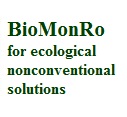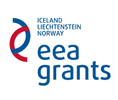|
Long-term National Monitoring
System of Bioaccumulation
of Airborne Heavy Metals
(BIOMONRO)
Results
R.1.1
The
list of species from Romania
that could potentially be used
as bioindicators. This list will contain all phytotaxa from the native flora
which can provide information regarding the quality of the environment
R.1.2
- The list of species from Romania
that could potentially be used
as biomonitors.
This list will contain all phytotaxa from the native flora which show
tolerance against the presence of heavy metals in the environment
R.1.3
Report regarding the use of species from Romania as
bioindicators
of the presence of heavy metals in the environment. The report will contain
the methodologies for assessing and selecting
bioindicator species from the
native flora
R.1.4
Report regarding the use of species from Romania as biomonitors of the
presence of heavy metals. The report will contain the methodologies for
assessing and selecting
species from the native flora that could potentially be used as biomonitors
R.1.5
Guide for using species in biomonitoring programmes. The guide will
present in detail all protocols needed in the biomonitoring activity. The
guide will be available online on the website of the BIOMONRO project
R.2.1
Map with the distribution of the biomonitoring stations at national level.
The map will present the biomonitoring stations in a standard regulated GIS
grid of 10 Χ 10 km and in
ETRS89
projection
R.2.2
Scientific report regarding the use of bryophytes in biomonitoring, and a
live collection of bryophytes as a source material for active biomonitoring
R.2.3
Scientific report regarding the use of lichens in biomonitoring, and a
live collection of lichens as a source material for active biomonitoring
R.2.4
Scientific report regarding the use of vascular plants in biomonitoring, and
a live collection of vascular plants as a source material for active
biomonitoring
R.2.5
Scientific report regarding the use of other groups of organisms in
biomonitoring. The report will contain methods and techniques in using
groups of organisms other than plants in biomonitoring programs
R.2.6.1
Scientific report regarding the active biomonitoring of the
bioaccumulation of lead,
cadmium, nickel, arsenic and mercury
R.2.6.2
Database with the results of the active biomonitoring of the
bioaccumulation of lead,
cadmium, nickel, arsenic and mercury
R.2.7.1
Scientific report regarding the passive biomonitoring of the
bioaccumulation of lead,
cadmium, nickel, arsenic and mercury
R.2.7.2
Database with the results of the passive biomonitoring of the
bioaccumulation of lead,
cadmium, nickel, arsenic and mercury
R.2.8.1
Scientific report regarding the active biomonitoring of the
bioaccumulation of other heavy metals than those
stipulated in Law no. 104/2011,
with negative effects on the environment and / or on human health
R.2.8.2
Database with the results of the active biomonitoring of the bioaccumulation
of other heavy metals than those
stipulated in Law no. 104/2011,
with negative effects on the environment and / or on human health
R.2.9.1
Scientific report regarding the passive biomonitoring of the
bioaccumulation of other heavy metals than those
stipulated in Law no. 104/2011,
with negative effects on the environment and / or on human health
R.2.9.2
Database with the results of the passive biomonitoring of the
bioaccumulation of other heavy metals than those
stipulated in Law no. 104/2011,
with negative effects on the environment and / or on human health
R.2.10.1
Scientific report regarding the active biomonitoring of the
bioaccumulation of some heavy metals of economic importance
R.2.10.2
Database with the results of the active biomonitoring of the
bioaccumulation of some heavy metals of economic importance
R.2.11.1
Scientific report regarding the passive biomonitoring of the
bioaccumulation of some heavy metals of economic importance
R.2.11.2
Database with the results of the passive biomonitoring of the
bioaccumulation of some heavy metals of economic importance
R.2.12
National plan for active and passive monitoring of the bioaccumulation of
airborne heavy metals. This plan will contain in detail all biomonitoring
techniques and methodologies adapted to the biomonitor species from Romania
R.3.1.1
Scientific report regarding
the efficiency of using forest belts as means to mitigate the effects of
heavy metals presence in the atmosphere
R.3.1.2
Database with the information regarding the efficiency of using forest belts
as means to mitigate the effects of
heavy metals presence in the
atmosphere
R.3.1.3
Methodology for estimating the risks associated with the use of
forest belts and alignments in reducing the concentration of heavy metals in
the atmosphere
R.3.2.1
Scientific report regarding the methods and techniques for reducing the
concentration of heavy metals in the atmosphere by their mobilisation from
mine dumps
R.3.2.2
Database with the information regarding the reduction of the concentration
of heavy metals in the atmosphere by their mobilisation from mine dumps
R.3.2.3
Methodology for estimating the risks associated with the use of
species from the native flora in fixating the soils contaminated with heavy
metals generated by mine dumps
R.3.3.1
Scientific method regarding the use of lichens and of vascular
plants in extracting heavy metals and reducing their concentration in the
atmosphere
R.3.3.2
Databases regarding the use of
lichens and of vascular plants
in extracting heavy metals and reducing their concentration in the soil and
in the atmosphere
R.3.3.3
Methodology for estimating the risks associated with the use of
lichens and cormophytes in the extraction of heavy metals
R.3.4.1
Scientific method regarding the use of lichens and vascular
plants in the extraction of heavy metals of economic importance
R.3.4.2
Cost-benefit report regarding the use of plants in the extraction
of some heavy metals of economic importance
R.3.5
National plan of using lichens and vascular plants in the
extraction of heavy metals and for reducing their concentration in the
environment. The plan will contain in detail all techniques and
methodologies for selecting, assessing and using vascular plants and lichens
in reducing the concentration of heavy metals in the environment. Each
technique and methodology will be accompanied by a cost-benefit report
R.4.1
National network for collecting, integrating, processing and
reporting data on the biomonitoring of heavy metals
R.4.2
Databases and lists. The primary databases will be developed in Access .mdb
format, and the structure of the database will be set for stocking field
data
R.4.3
Protocol for collecting data on heavy metal biomonitoring at
national level
R.4.4
Protocol for integrating data on heavy metal biomonitoring at
national level
R.4.5
Protocol for processing data on heavy metal biomonitoring at
national level
R.5.1.1
Technical report regarding the procedure of establishing the
critical dozes for alert for the bioaccumulation
of lead, cadmium, nickel, arsenic and mercury
R.5.1.2
Scenario for environmental exposure when the bioaccumulation
of lead, cadmium, nickel, arsenic
and mercury exceeds the critical dozes for alert
R.5.2.2
Technical report regarding the procedure of establishing the
critical dozes for alert for the bioaccumulation
of other heavy metals with
negative effects on the
environment and / or on human health
R.5.2.2
Scenario for environmental exposure when the bioaccumulation
of other heavy metals with
negative effects on the
environment and / or on human health
exceeds the critical
dozes for alert
R.5.3
Protocol for alert in the
case when it is considered that the environment migh suffer a long-term
effect
R.5.4
Technical report regarding the testing of the biomonitoring
system. This report will present in detail the functioning of the
biomonitoring system developed through this project
R.MP.1
Trimestral progress reports and the final report
R.MP.2
Trimestral progress reports and the final report
R.MP.3
Trimestral progress reports and
the final report
|











